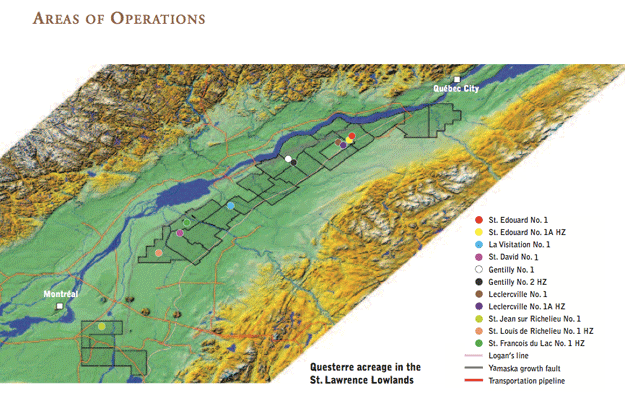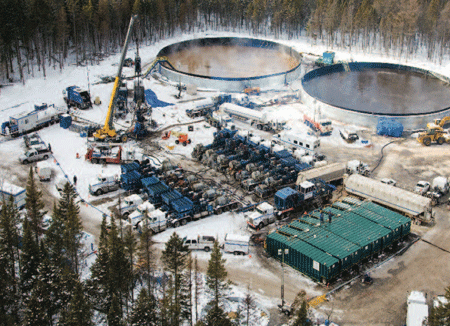Questerre Energy Corporation
From Wikimarcellus
←Older revision | Newer revision→
Questerre Energy Corporation (TSX:QEC) (OSLO:QEC) is a Calgary, Alberta-based junior exploration company which holds the largest acrage position in the Utica shale in the Saint Lawrence Lowlands, Quebec, Canada.

Map of Questerre's St. Lawrence Lowlands well locations and acreage
Courtesy of Questerre Energy Corp.
In Septeber, 2008 Questerre was participating in a farm-in agreement with Talisman Energy Inc., the well operator, to drill three wells in the St. Lawrence lowlands. The wells were to test multiple horizons including the Trenton-Black River (TBR), Utica and Lorraine shale formations. At the time, it was reported that the first of these three wells had been spud.
Questerre and Talisman's permit sits squarely in the middle of the St. Lawrence Lowlands located between Logan’s Line, a subsurface thrust fault on the east, and the Yamaska growth fault in the west. It extends from Quebec City south to a point beyond Lac Saint Pierre.
According to a November, 2008 report, Questerre was also participating in a joint-venture Utica shale drilling program on its Yamaska property which consisted of 112,000 acres in the Province of Quebec. The report stated that at the time two horizontal wells had been drilled, and a pilot program of horizontal drilling was planned for 2009. Candian Forest Oil and Gastem were listed as joint-venture partners. Questerre owns a 20% working interest as does Gastem, and Canadian Forest Oil is the development operator and owns the balance of 60%. It is a completely different property than the aforementioned farmed-in one with Talisman and the well operators are different. Update: Forest Oil completed the testing of two prototype horizontal wells targeting the upper Utica shale. Stable production between 100 and 800 Mcf with initial production (IP) up to 4 Mmcf/d. Forest planned to shoot 2D seismic to compliment it drilling program.
In December, 2008 the company reported that it had completed drilling the La Visitation #1 well in the St. Lawrence Lowlands, Quebec. and the well was being cased for shale gas testing. This was one of a series of wells which had been drilled under the previously mentioned Talisman farm-in for three wells (now grown to four).
In April 2009 the company announced that it had completed drilling the St. Edouard #1 well which had promising TBR interval gas shows. An open-hole test was being planned. Other intervals to be tested at the same time were the Lorraine and Utica shales. St. Edouard #1 was the forth and final earning well in the series required to meet the terms of its farm-in agreement with Talisman Energy. In July, 2009 Questerre announced that in fact Talisman had met all requirements for it to earn its 75% share under the farm-in.
At the end of April, 2009 the company announced the results of a vertical well, the St. David #1 that was fracture stimulated and during an initial test period of 17 days flowed at the rate of 450 Mcf/d. The previously mentioned La Visitation #1 well had flowed at a rate of 300 Mcf/d during a 5 day initial test after fracing. The production logging from both wells indicate most of the production was flowing from a similar Utica interval.
The well operator was beginning a program of 2-D seismic data acquisition that was to be used to help identify well pad locations. Each pad potentially included multiple horizontal wells.
In May, 2009 Questerre was reporting initial production of between 300 mcf/d - 800 mcf/d from its vertical well drilling program. The gas was coming from the same Utica shale interval in each of the wells.
In late June, 2009, the previously-mentioned fourth well in the above series, St. Edouard #1 was being fracture stimulated and tested for different intervals. Both the Utica and Lorraine shale formations were to be evaluated. The Trenton-Black River interval had previously been tested and for three days had flowed at the initial rate of 2.2 Mmcf/d with wellhead pressure of 2,000 psi on a 7/32-inch choke after the acid stimulation. However, this flow rate was not deemed significant enough to justify a tie-in for the well. This well offsets another one called the Leclercville #1 that produced 900 mcf/d from the Utica interval in testing.
At the end of August, 2009 the company announced that it had received an estimate from the reservoir engineering firm, Netherland, Sewell & Associates, Inc (NSAI) , that was 150 Bcf per square mile; that is, two thirds higher than had previously been given for Questerre's St. Lawrence Lowlands gas play. NSAI also estimated that Questerre's prospective recoverable resources to be anywhere from 2.2 Tcf to 8.0 Tcf. Their best estimate was 4.28 Tcf. (Update: The Annual Report states 4.36 Tcf) NSAI's updated assessment had in part been based upon the above mentioned St. Edouard #1 well that tested at rates of 700 mcf/d from the Utica shale interval. It had been on a 1 inch choke for 10 days of tests after fracture stimulation. At the time of the report, the well had been shut-in for pressure buildup. According to one report, the inital production from the Utica interval had been 2.6 Mmcf/d for this well.

Completion operations on St. Edouard #1A HZ
Courtesy of Questerre Energy Corp.
In a November, 2009 quarterly update Questerre mentioned that it had spud a horizontal well, St. Edouard #1A HZ, that was to target the middle Utica shale. It is part of a broader drilling program the company had begun intended to evaluate the commercial aspects of the Utica shale play. Update: This well had been drilled and cased to a total depth of 10,436 feet with a 3281 foot lateral. Fracture stimulation was to take place in January, 2010. (See completion results below announced in late January)
Results were announced at the end of January, 2010 on completion of the St. Edouard #1A horizontal well. The initial production rate was 12 Mmcf/d and during the test it settled out to a flow rate of 6 Mmcf/d. It had used 8 frac stages. During an extended test that followed, the well continued to flow at 5 Mmcf/d. The latter rate was with a tubing pressure reading of 640 psi choked at 5/8 inch. The St. Edouard #1 vertical well was used for collecting microseismic data. The entire Utica interval was successfully accessed by the frac stages of the horizontal #1A. The company and operator were evaluating options for setting up a pipeline for the well to tie it into a gathering system. The well continued to be on a long-term production test with results in line with expectations. The company planned to drill 2 or 3 additional horizontal wells during 2010 and shoot 3D seismic over proposed pilot pad locations in the area. Update: After being tested for 134 days, the St. Edouard No. 1A horizontal well was producing at a rate of approximately 1.4 Mmcf/d. The company continued to evaluate the production and pressure of this well in conjunction with microseismic data collected when the well had been fraced.
A report surfaced in February, 2010 that Questerre and Canadian Quantum had jointly announced that they had finished drilling the Gentilly #2 and testing was to begin later in the year. It was the second horizontal well drilled in the Lowlands Utica play. Talisman had been well operator. The latter had also been drilling another horizontal well, the St. Edouard #2. Drilling results on both of these wells was expected to be available by the end of February or early March, 2010. Both the Gentilly #1 and St. Edouard #1 had been single stage fracs. The later #2 wells in the series were expected to be multiple stage fracs. Testing was to settle the issue of whether these wells could produce sufficient flows of natural gas to be of commercial value. The companies were looking for production between 1.5 and 3.0 Mmcf/d to verify commercial volume.
Update #1: A press release appeared in May, 2010 by joint venture partner, Canadian Quantum, stating that Gentilly #2Hz was to be fracture stimulated in early June, 2010. Further details are also available on the Canadian Quantum wiki page.
Update #2: A later July, 2010 release, this time from Questerre, stated that completion operations had begun on the Gentilly #2Hz. Both the middle and lower intervals of the Utica shale were to be tested. The lateral runs 2,297 feet, and the completion involved a 5-stage frac. Partner Talisman Energy was to conduct the frac activities. The neighboring vertical Gentilly No. 1 was to be used for microseismic monitoring to evaluate the effectiveness of the fracs. Analysis of wells previously fraced in the area validated the finding that fracturing does not propogate beyond the Utica shale which sits almost 5,000 feet below the fresh water aquifer.
In mid-May, 2010 Questerre announced that it had spud the Fortierville #1 horizontal well located somewhere between the Gentilly #2 and St. Edouard #1A. It was to reach a total depth of 11,282 feet and have a 3,280 foot lateral drilled in the middle Utica interval. The company expected the completion to be an 8 stage frac. Results were expected during the third quarter, 2010. The release also stated that the aforementioned 3 d seismic was in the initial planning stages. Update: In July, 2010 the company announced that drilling had finished on Fortierville #1 in late June, 2010. It had been drilled to a final depth of 11,122 feet with a 3,280 foot lateral. Completion of this well had been scheduled in the fall when equipment needed by a partner was to become available.
The company announced in July, 2010 that drilling was underway on another horizontal well, the St. Gertrude #1Hz located approximately 7.5 miles southwest of Gentilly #2Hz. It was to test an unstructured area of the play fairway and be drilled to a depth of 10,827 feet with a 3,281 foot lateral. Completion was to involve an 8-stage frac to be concluded later in the year.
Questerre's St. Lawrence Lowlands leasehold consisted of roughly 833,000 gross acres located in the Utica shale fairway between Logan's line and the Yamaska growth fault. It's main joint venture partner had been Talisman Energy. Of this total, Talisman retained a 75% working interest in approximately 720,000 joint acres. Questerre held a 25% interest in this same acreage and maintained a 4-1/4% gross override on Talisman's share of production.
- Michael Binnion is President and CEO of Questerre.
- Anela Dido is a Questerre spokesperson.

